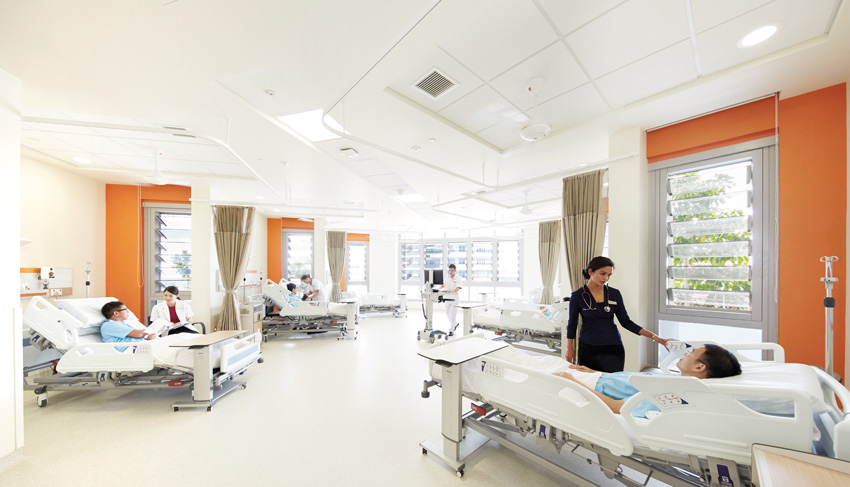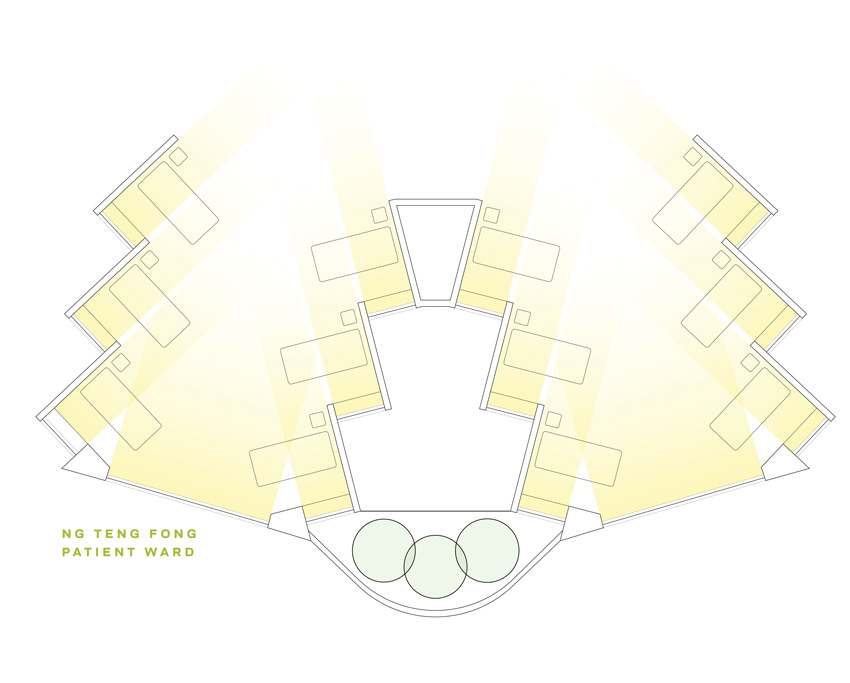Health Care and Natural Ventilation
Learning Objectives:
- Outline the benefits of naturally ventilated health-care facilities.
- Discuss hurdles to implementing natural ventilation in North American health-care facilities.
- Discuss industry standards and regulations pertaining to ventilation in health-care facilities.
- Explain physical phenomena relevant to natural ventilation, such the Venturi effect and stack ventilation.
Credits:
This course is approved as a core course
View course on architecturalrecord.com »
At a scale unheard of in their home country, American architecture firms are using natural ventilation to achieve energy savings, resilience, and patient comfort in two major health-care projects in Asia. At Singapore’s Ng Teng Fong General Hospital (NTFGH), one of this year’s AIA COTE Top Ten Award winners, more than 80 percent of bed spaces are cooled and ventilated relying on passive strategies alone. At XiangYa Hospital, a 5.6 million-square-foot medical facility in Changsha, in south central China, slated to start construction this summer, windows will be the primary source of cooling and ventilation for all patient rooms.

PHOTOGRAPHY: © RORY DANIEL AND CPG CONSULTANTS
MADE IN THE SHADE
The facades of Ng Teng Fong General Hospital (left) in Singapore rely on several types of shading devices. The patient-room wings (right) have deep precast concrete overhangs that support plants. These provide additional shade, evaporative cooling, and views.
Although natural ventilation is common internationally, North Americans are accustomed to full mechanical ventilation, says Travis English, chief design engineer for health-care consortium Kaiser Permanente and a member of a natural-ventilation task group for the American Society of Heating, Refrigerating and Air-Conditioning Engineers (ASHRAE). “So, a naturally ventilated health-care building here is going to be somewhat countercultural,” he says. The few naturally ventilated North American health-care facilities that do exist, such as Peace Island Medical Center, an award-winning facility on San Juan Island, Washington, tend to reflect considerations so specific to their particular circumstances that they reinforce just how unusual natural ventilation in North American health care really is.
So how do international health-care facilities achieve comfortable environments with natural ventilation? And should North Americans expect to see more of such facilities?
From the very beginning, the design priority for the 1.84 million-square-foot NTFGH, which opened in 2015, was to make the patient’s experience far more pleasant, says William Roger, director of health care in the San Francisco office of HOK, architects for the project with CPG Consultants and Studio 505. A pre-design tour of Singapore’s public hospitals found standard, multipatient wards configured so that only the patient at the end of the room had access to a window—and drawing that patient’s privacy curtain blocked access to light and air for patients farther from the building perimeter. Bedside fans only served to circulate increasingly warm air.
To improve the healing environment, airflow was paramount: research has shown that, in tropical climates, higher temperatures (from 79 to 84 degrees Fahrenheit) in rooms with ceiling fans are more comfortable than cooler spaces without them. The design team’s solution opens the floor plan of the standard ward like the wings of a bird, a move that creates a semiprivate corner with its own operable window for each patient bed. The outside walls of the splayed floor plan catch the wind and channel it toward the windows. As the floor plan narrows, air throttles through the tightening spaces in a Venturi effect, which increases air velocity without mechanical intervention. Single-loaded corridors narrow the building depth, promoting more effective cross ventilation and reducing the passage of air across multiple patients. “Even on a calm day,” says Roger, “you can feel a breeze.”
Creating a comfortable temperature in Singapore’s tropical climate using only natural ventilation begins long before the breeze enters the room, however. NTFGH’s facades comprise multiple layers and elements, including vertical sunshades and deep overhangs of precast concrete. In addition to providing shade, the overhangs support plantings that contribute additional shade and some evaporative cooling, as well as views. Facade design is unique to each orientation, providing 60 percent shading on critical facades and 40 percent on others. Critical facades are those for which shading is essential to providing patient comfort or other required conditions. The facade at the patient ward, for example, would be more heavily shaded than the facade adjacent to a corridor. With no need for insulation, the building’s weather envelope consists of inexpensive prefabricated panels supporting two types of windows: upper, operable windows, and lower, hurricane windows with vents that let in air while keeping out wind and rain.
NTFGH’s combined energy conservation strategies achieve a design Energy Use Intensity (EUI)—calculated by dividing the total energy consumed annually by the total gross floor area—of 72 kBtu per square foot per year. This represents a 38 percent reduction compared with a typical Singapore hospital, and a 69 percent reduction compared with a typical U.S. hospital.
While it should be no revelation that natural ventilation and passive cooling help reduce energy consumption, it may be surprising that the strategy also plays a role in conserving water. Because cooling towers are one of the largest consumers of water in fully air-conditioned hospitals—especially in a hot climate like Singapore’s—the use of passive design to condition 70 percent of the building constitutes the facility’s single most effective water-conservation measure.


IMAGES: © RORY DANIEL AND CPG CONSULTANTS (TOP); COURTESY HOK (BOTTOM)
FAN PLAN
Multi-bed wards (top and bottom) at Ng Teng Fong in Singapore are shaped like fans. The strategy creates a semi-private corner with its own operable window for each patient and helps promote the Venturi effect and cross ventilation.
In selecting the project as an AIA COTE Top Ten winner, the jury commented that “this project is an extraordinary model for hospitals to behave as healing environments not seen in the United States” and “the passive strategies demonstrated here are a model for hospitals around the world.”
As with NTFGH, the mandate for passive cooling and ventilation at XiangYa Hospital derived from established health-care design practice in the region. “We know how to open windows,” the client told Boston-based Payette Architects in establishing the design parameters for the 2,500-bed facility. “We do not want air-conditioning or any mechanical systems whatsoever in the patient units.” The city’s current hospital is naturally ventilated, and the client expects the new one, which will consist of zigzagging inpatient wings atop orthogonal medical-service podiums, to improve patients’ thermal comfort through a more deliberate approach.
In many ways, Changsha is well suited to natural ventilation. Air quality is not a problem, as it is in many of China’s northern cities, and Changsha’s subtropical climate has four distinct seasons. However, increasingly frequent summer heat waves make it difficult to guarantee comfortable conditions through natural ventilation alone. “We need to design a system to protect the weakest,” says Alejandra Menchaca, a senior building scientist with Payette, “and we couldn’t quite do it with natural ventilation year-round.” The design solution will provide passive conditioning for what’s estimated to be 70 percent of the cooling season, based on adaptive comfort thresholds, and staff will turn on mechanical air-conditioning to moderate peak temperatures. The concept of adaptive comfort recognizes that people feel comfortable across a wider range of indoor temperatures if they have control over window operability. It’s also a function of outdoor temperature: on a hot day, people are comfortable at warmer indoor temperatures, and vice versa.
To move air, natural-ventilation systems rely on pressure differentials, which can be generated either by the wind for cross ventilation (as at NTFGH) or by temperature or humidity differences. In stack ventilation, an example of this, warmer air exits high and draws cooler air in low. This can allow a room to be self-ventilating, taking air in and exhausting it through openings in the same wall. Such is the strategy planned for XiangYa.









